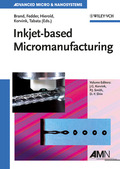Inkjet-based Micromanufacturing
Advanced Micro and Nanosystems (Band Nr. 9)

1. Auflage April 2012
XVI, 372 Seiten, Hardcover
217 Abbildungen (13 Farbabbildungen)
10 Tabellen
Handbuch/Nachschlagewerk
Kurzbeschreibung
A unique combination of vital yet hard-to-come-by practical knowledge in one handbook and ready reference, offering a well-balanced industrial and academic perspective. From the basics of instrumentation, via patterning and its control to system integration for applications.
Jetzt kaufen
Preis: 195,00 € *
* Serienpreis auf Anfrage
Preis inkl. MwSt, zzgl. Versand
Euro-Preise für Wiley-VCH- und Ernst & Sohn-Titel sind nur für Deutschland gültig. In EU-Ländern gilt die lokale Mehrwertsteuer. Portokosten werden berechnet.
- Gedruckte Ausgabe vergriffen -
Inkjet-based Micromanufacturing Inkjet technology goes way beyond putting ink on paper: it enables simpler, faster and more reliable manufacturing processes in the fields of micro- and nanotechnology. Modern inkjet heads are per se precision instruments that deposit droplets of fluids on a variety of surfaces in programmable, repeating patterns, allowing, after suitable modifications and adaptations, the manufacturing of devices such as thin-film transistors, polymer-based displays and photovoltaic elements. Moreover, inkjet technology facilitates the large-scale production of flexible RFID transponders needed, eg, for automated logistics and miniaturized sensors for applications in health surveillance. The book gives an introduction to inkjet-based micromanufacturing, followed by an overview of the underlying theories and models, which provides the basis for a full understanding and a successful usage of inkjet-based methods in current microsystems research and development
Overview of Inkjet-based Micromanufacturing:
Thermal Inkjet
Theory and Modeling
Post-Printing Processes for Inorganic Inks for Plastic Electronics
Applications
Inkjet Ink Formulations
Inkjet Fabrication of Printed Circuit Boards
Antennas for Radio Frequency Identification Tags
Inkjet Printing for MEMS
SYMBOLS AND ACRONYMS
INTRODUCTION
Overview
Combinatorial Chemistry
Drop-On-Demand Inkjet: Piezo Inkjet, Pipejet, Thermal Inkjet, Electrohydrodynamic Inkjet
THEORY AND MODELING
Inkjet Fundamentals
Crosstalk
Patterning
Drying
Sintering
INKJET SYSTEMS
Inkjet Print Head
Monitoring: Visual Monitoring, Self-Sensing
Comparison of Calibration Methods in Inkjet Printing
System Integration
Inks
APPLICATIONS
Displays: Color Filter Fabrication, Polymer Displays, Quantum-Dot LED Displays with Printable Processes
Thin-Film Transistors: OTFT, Metal Oxides
Printed Circuit Boards
Photovoltaics
Rapid Prototyping: Phase Change, High Aspect Ratio Printing
Sensors: Chemical Sensors, RF Antennas, Medical Imaging (MRI Coils)
Actuators
MEMS
Biological Devices
Connects and Interconnects
Patrick J. Smith is a Lecturer in Manufacturing Technology for the University of Sheffield, UK. He has published over 40 journal and conference papers, and has 3 patents. His main research interests are concerned with reactive inkjet printing, controlled crystallisation using inkjet and additive manufacture.
Dong-Youn Shin is Assistant Professor at the Pukyong National University in Busan, South Korea. Before his appointment, he was research engineer at LG Chem Research Park and then senior research scientist in the division of nanomechanical systems at the Korean Institute of Machinery and Materials in South Korea. He holds 38 patents and over 70 conference and journal papers. His research interests lie in maskless lithography and fine pattern generation for displays and electronics with the piezo inkjet printing technology.


